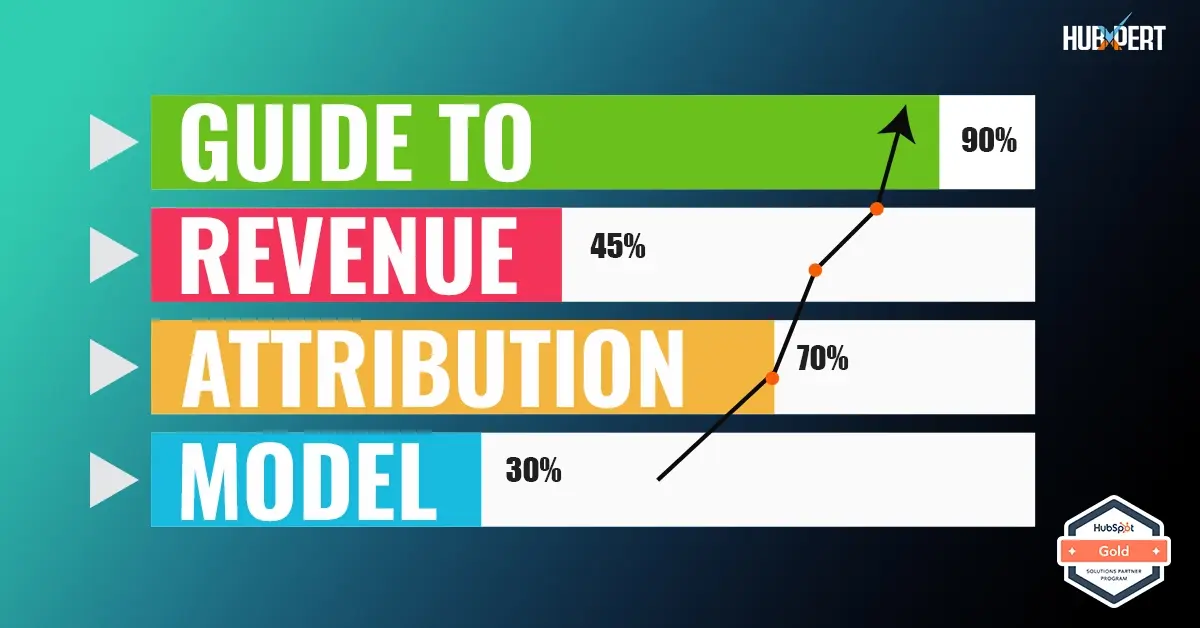The Beginner's Guide to Revenue Attribution Models (2025 Update)

In today's competitive market, all marketers run campaigns on different channels such as social media, email, and paid ads. More channels mean more data, and to optimize your campaigns, you need to make full use of your data. How can you do that?
The answer is - Revenue Attribution.
Now, what is revenue attribution? How can you use that? We have got you covered.
Revenue attribution is the process of determining the sources and channels that contribute to a company's revenue. It helps businesses understand which marketing efforts and sales activities drive revenue and allows for better decision-making and resource allocation.
There are various methods and models used for revenue attribution. Still, the ultimate goal is to accurately distribute resources to the marketing campaigns, channels, and touchpoints that influence a customer's purchase decision.
By understanding the basics of revenue attribution, businesses can gain valuable insights into their customer journey and optimize their marketing and sales strategies to maximize revenue generation.
Who needs Revenue Attribution?
Any kind of business.
Let me tell you why! The customer journey and buying process are undoubtedly lengthy and complex in the business realm. Revenue attribution serves as a crucial tool in effectively bridging the gap between different departments and teams.
A lot of businesses fall into the trap of running campaigns without tracking where their revenue comes from. This is where revenue attribution comes in. By attributing revenue to specific marketing channels and efforts, you can gain valuable insights into which ones drive sales and which ones are simply wasting money. With this knowledge, you can optimize your marketing spend, identify areas for improvement, and finally start seeing the return on investment you deserve.
If your business operates campaigns across various digital platforms such as social media, search engines, and display advertising. You have a multi-stage sales process with different touchpoints; you may find it challenging to track the effectiveness of your marketing efforts and determine the return on investment (ROI).
Additionally, you might need help allocating and optimizing your marketing budget effectively, especially in a highly competitive market. Furthermore, as your business evolves, you may be looking to refine your marketing strategy to stay ahead in the competitive landscape. Implementing a robust revenue attribution system in all these scenarios can address these challenges and provide valuable insights to help your business thrive.
Does that mean only the RevOps team needs to understand how revenue attribution works? Not really! Every team needs to understand the fundamentals of Revenue Attribution so that teams can collaborate smoothly.
Teams can allocate resources more effectively by understanding the contributions of different teams, channels, and campaigns to revenue generation. This enables them to identify areas that require increased investment or support based on their revenue-generating potential, ensuring that the organisation's financial resources are strategically allocated for maximum impact.
Why Revenue Attribution? Not Conversion Tracking?
Revenue Attribution is a bit different from Conversion Tracking.
Conversion Tracking usually tracks simple actions taken by people on a certain platform. It usually focuses on a single action, like a form submission or download. It tells you how often that action occurred but not if it led to revenue. This limited view can be misleading as it needs to consider the entire customer journey. Customers interact with your brand at multiple touchpoints before converting, and using a single-touch attribution model can be inaccurate, assigning all credit to one touchpoint.
A question might arise. Did those conversions translate into actual sale where Revenue Attribution comes in.
It goes deeper, beyond just one action, and follows the customer journey. Consider a customer who discovers your helpful blog post, then sees your social media ad a week later, and finally clicks to purchase your product. While conversion tracking may only attribute the sale to the social media ad, revenue attribution takes into account the contributions of both the blog post and the advertisement in making the sale happen.
Revenue Attribution Models
Revenue Attribution models fall into two categories.
Single-touch attribution
First-touch
Last-touch
Multi-touch attribution
Linear Attribution
Time-decay
U-shaped
W-shaped
Full path
J-shaped
Inverse J-shaped
Implementing Revenue Attribution Strategies
Implementing revenue attribution strategies requires a combination of data collection, analysis, and technology. Here are some steps to consider:
Define your goals
Gather relevant data
Choose the right tools
Develop a framework
Analyse and interpret the data
Iterate and refine
Leveraging Data Analytics for Revenue Attribution
Data analytics plays a crucial role in revenue attribution. By leveraging data analytics techniques, businesses can gain deeper insights into their customer journey and revenue generation process. Here are some ways to leverage data analytics for revenue attribution:
Track and analyse customer interactions
Segment your customer data
Utilise predictive analytics
Integrate data from different sources
Measuring Success and Adjusting Strategies
Measuring the success of revenue attribution strategies is essential to ensure their effectiveness and make necessary adjustments. Here are some key metrics to consider:
Revenue Contribution by Channel
Return on Investment (ROI)
Customer Lifetime Value (CLV)
Conversion Rate
Marketing Qualified Lead
Sales Qualified Lead
Customer Acquisition Cost (CAC)
Businesses can adjust their revenue attribution strategies based on the metrics and insights gathered. This may involve reallocating marketing budgets, optimizing campaigns, or refining the attribution model used. Continuous measurement and adjustment are crucial for maximizing revenue generation.
In summary, revenue attribution serves as a valuable tool for gaining insights into the influence of marketing and sales activities on a company's financial performance. Through the implementation of successful revenue attribution strategies, the utilisation of data analytics, and the assessment of achievements, businesses can enhance their revenue generation capabilities and foster sustainable growth.
Founder & CEO @ Hubxpert. My goal is to make every company using HubSpot succeed in their marketing organisation and automation.

Ratul Rahman
Table of Contents:
Subscribe to our newsletter

HubSpot: Elevating Bangladeshi Consultancies Beyond Excel
Our 2024 Beginner's Guide to Revenue Attribution Models explains key models & helps you choose the right one to optimize campaigns & boost ROI.

Why Bangladeshi Consultancies Lose 30% of Leads—and How to Fix It
Our 2024 Beginner's Guide to Revenue Attribution Models explains key models & helps you choose the right one to optimize campaigns & boost ROI.

Bangladeshi Study-Abroad Marketing: Converting Social Media into Leads
Our 2024 Beginner's Guide to Revenue Attribution Models explains key models & helps you choose the right one to optimize campaigns & boost ROI.

Best CRM for Education Businesses in Bangladesh
Our 2024 Beginner's Guide to Revenue Attribution Models explains key models & helps you choose the right one to optimize campaigns & boost ROI.

Modern Sales Systems That Actually Convert for Bangladeshi Consultancies
Our 2024 Beginner's Guide to Revenue Attribution Models explains key models & helps you choose the right one to optimize campaigns & boost ROI.

What I Learned Helping Healthcare Businesses Fix Their Sales & Marketing Process
Discover how connected CRM systems like HubSpot can transform healthcare sales and marketing processes, improving patient engagement, reducing no-shows, and streamlining workflows.
-

HubSpot: Elevating Bangladeshi Consultancies Beyond Excel
Discover how businesses are using HubSpot to streamline marketing efforts, boost lead generation, and drive sustainable growth through data-driven strategies.
Marketing -

Why Bangladeshi Consultancies Lose 30% of Leads—and How to Fix It
Discover how businesses are using HubSpot to streamline marketing efforts, boost lead generation, and drive sustainable growth through data-driven strategies.
Marketing -

Bangladeshi Study-Abroad Marketing: Converting Social Media into Leads
Discover how businesses are using HubSpot to streamline marketing efforts, boost lead generation, and drive sustainable growth through data-driven strategies.
Marketing -

Best CRM for Education Businesses in Bangladesh
Discover how businesses are using HubSpot to streamline marketing efforts, boost lead generation, and drive sustainable growth through data-driven strategies.
Marketing -

Modern Sales Systems That Actually Convert for Bangladeshi Consultancies
Discover how businesses are using HubSpot to streamline marketing efforts, boost lead generation, and drive sustainable growth through data-driven strategies.
Marketing -

What I Learned Helping Healthcare Businesses Fix Their Sales & Marketing Process
Discover how businesses are using HubSpot to streamline marketing efforts, boost lead generation, and drive sustainable growth through data-driven strategies.
General




